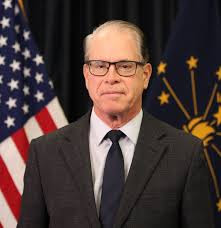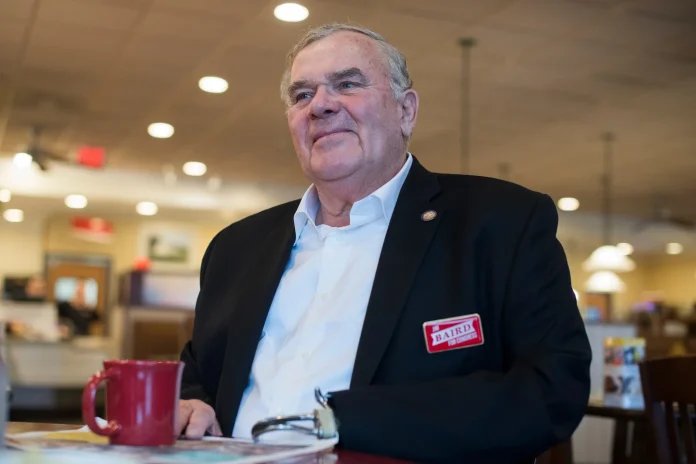Beginning at 10 p.m. on Dec. 31, New Year’s Eve revelers in Evansville and neighboring counties can call a Lyft taxi either for free or at a steep discount by using a Logan’s Promise promo code, “SAFERIDE2026,” slashing $25 from the total fare price. Rides with fares of $25 or less are thus free.
Governor Braun Leverages Indiana Workforce Development Board to Grow Jobs and Wages for Hoosier Workers
INDIANAPOLIS – Governor Mike Braun has signed an executive order reinstating Indiana’s State Workforce Development Board to strengthen Indiana’s statewide workforce development strategy, grow jobs and higher wage opportunities for Hoosiers, and ensure full alignment with the federal Workforce Innovation and Opportunity Act. The executive order positions the Board as a central coordinating body to align employers, education and training providers, and state agencies around measurable workforce outcomes.
“My most important responsibility is making life better for Hoosier families on the kitchen table issues that really matter, and that means new job opportunities, higher wages, and a clear path to a high-paying skilled career. We will use the Indiana Workforce Development Board to bring together an elite team of job creators and workforce development experts to help create new opportunities and bigger paychecks for Hoosier workers.” — Governor Mike Braun
The Workforce Development Board will include entrepreneurs and representatives from businesses of all sizes. Members will represent urban, rural, and suburban Hoosier communities.
The Workforce Development Board will advise the Governor and the Secretary of Commerce on workforce development strategy, including a review of statewide policies and programs with recommendations on actions the state should take to strengthen Indiana’s workforce. The Board will develop comprehensive state performance accountability measures to track results and ensure success for Hoosier workers.
Reinstating the Board reinforces Indiana’s commitment to an employer-led, outcomes-driven workforce system that supports talent pipelines, regional economic growth, and long-term wage advancement.
Congressman Baird Announces Significant Health Care Funding for Indiana Through Rural Health Transformation Program
Washington, D.C. – Congressman Jim Baird (IN-04) announced that the State of Indiana will receive nearly $207 million in funding for Fiscal Year 2026 through the Rural Health Transformation (RHT) Program.
“Hoosiers in rural communities deserve access to timely, high-quality care,” said Congressman Baird. “I was proud to support the One Big Beautiful Bill Act, which authorized the Rural Health Transformation Program to deliver vital funding that will help address provider shortages, barriers to accessing care, and workforce shortages, while allowing our rural health care providers to continue to provide quality care. I am pleased to see these taxpayer funds returned to Hoosiers so Indiana can increase access to care and improve patient outcomes. I thank President Trump for signing the One Big Beautiful Bill Act into law and CMS Administrator Dr. Mehmet Oz for his leadership in delivering this critical funding for Hoosiers and Rural America.”
The RHT Program was created by the One Big Beautiful Bill Act, which was signed into law by President Trump on July 4, 2025. The RHT Program empowers states to strengthen rural communities by improving health care access, quality, and outcomes by transforming the health care delivery ecosystem. RHT Program funding consists of $50 billion allocated to approved states over five fiscal years, with $10 billion available each fiscal year, beginning in Fiscal Year 2026 and ending in Fiscal Year 2030. Fifty percent of this funding is distributed equally to all approved states, and the remaining 50% will be allocated by the Centers for Medicare & Medicaid Services (CMS) based on a variety of factors including rural population, the proportion of rural health facilities in the state, the situation of certain hospitals in the state, and other factors to be specified by CMS.
More information on the Rural Health Transformation Program can be found here.
Important Changes to SNAP Benefits Starting January 1
Indiana is launching Smart SNAP, a new initiative to promote healthier food choices. Beginning January 1, 2026, sugary drinks and candy will no longer be eligible for purchase with SNAP benefits. This change is part of Governor Braun’s Make Indiana Healthy Again initiative. Learn more about what this means for you by visiting the Smart SNAP webpage.
Screaming Eagles visit SIUE, Lindenwood
EVANSVILLE, Ind. – University of Southern Indiana Men’s Basketball opens 2026 and the Ohio Valley Conference schedule on New Year’s Day with a visit to SIU Edwardsville in Edwardsville, Illinois. The opening weekend of 2026 concludes January 3 when USI visits Lindenwood in St. Charles, Missouri.
The Screaming Eagles (3-9, 0-2 OVC) are hoping the quick road trip can get the team on track after a rough 0-2 start to OVC play. USI could not hold off Little Rock in the conference opener, losing 77-62, and suffered a heartbreaking loss to Morehead State, 64-60, in overtime at Liberty Arena.
Senior guard Cardell Bailey led the way for the Screaming Eagles on the homestand with 17.5 points per game, while senior guard Ismail Habib and junior guard Kaden Brown posted 16.5 points and 10.0 points per game, respectively.
For the season, Habib has been posting 17.9 points per game to lead the Ohio Valley Conference and USI in scoring. Bailey is second on the team in scoring with 14.3 points per contest this season and is averaging 18.0 points per outing in thelast five games.
SIUE (8-5, 1-1 OVC) lost its 2025-26 OVC opener at Eastern Illinois, 76-72, in overtime, but bounced back to defeat Western Illinois, 66-61, on the road. The Cougars are 3-2 in the last five games and 5-5 in the last 10.
USI leads the all-time versus SIUE, 46-25, since the series began in the 1970s. USI also holds a 24-8 lead in conference games, both OVC and the old Great Lakes Valley Conference, since 1995.
SIUE won the first game last year in Edwardsville, 82-76, while USI took the second game at Liberty, 82-68.
Lindenwood (8-5, 2-0 OVC), which is tied for first in the OVC after the first two games, is 2-0 in the OVC after posting a win over Eastern Illinois, 82-74, on the road, and Western Illinois, 92-76, at home. The Lions, which lost to Missouri State, 70-65, in its final non-conference game before the holidays, have won six of its last seven.
USI leads the all-time series, 8-2, after splitting the conference games last season. USI won at Liberty Arena, 80-73, and fell at Lindenwood, 81-78, in overtime.
Attorney General Todd Rokita leads multistate coalition supporting President Trump’s policy to record biological sex on U.S. passports
Attorney General Todd Rokita this week led a coalition of 24 states and the Arizona Legislature in filing an amicus brief with the U.S. Court of Appeals for the First Circuit, supporting the Trump administration’s policy of listing biological sex — rather than subjective gender identities — on U.S. passports.
The brief calls for reversal of a district court’s preliminary injunction blocking the policy in Ashton Orr, et al. v. Donald J. Trump, et al., arguing that the Constitution permits the government to define “sex” as the objective, biological characteristic of male or female for official documents.
“Passports are official government property, and allowing self-defined entries would create chaos, inconsistency, and endless administrative problems while undermining accurate identification.” Attorney General Rokita said. “Government records must reflect verifiable biological reality — the same standard used for centuries — rather than ever-changing personal perceptions that could lead to unlimited options and unreliable documentation.”
The coalition contends that recording biological sex aligns with centuries of historical practice, dictionary definitions, Supreme Court precedent, and rational government interests in uniform, verifiable records. It notes that subjective gender identities can change and multiply indefinitely, making them unsuitable for official documents like passports. The brief also highlights the U.S. Supreme Court’s recent stay of the injunction, signaling the policy’s likely constitutionality.
Joining Indiana are the states of Alabama, Alaska, Arkansas, Florida, Georgia, Idaho, Iowa, Kansas, Kentucky, Louisiana, Mississippi, Montana, Nebraska, North Dakota, Ohio, Oklahoma, South Carolina, South Dakota, Tennessee, Texas, Utah, West Virginia, and Wyoming, as well as the Arizona Legislature.
HOT JOBS
|
||||||||||||||||||||||||||||||||||||||||||||||||||||||||||||||||||||||||||||||||||||||||||||
|
Aces Drop High Scoring Affair to Murray State
EVANSVILLE, Ind. – The University of Evansville women’s basketball team put up their highest scoring output of the season on Monday evening, but fell short in a 90-80 loss to Murray State at Meeks Family Fieldhouse.
Camryn Runner (Cicero, Ind./Hamilton Heights) posted her fourth 20-plus point performance of the season with 20 to lead the Aces. Runner also notched a career-high with nine assists, the most by an Ace since November 12, 2023. Eight different Aces found the scoring column, including season-highs by Georgia Ferguson (Waterloo, Ontario/Cairine Wilson Secondary School) with 10, BreAunna Ward (St. Louis, Mo./John Burroughs School) and Kylee Norkus (Naperville, Ill./Neuqua Valley) with nine, and Georgia Cox (Ballarat, Australia/Ballarat Rush) with eight.
Murray State grabbed control of the game early, opening the game on an 11-0 run. Cox snapped the run by scoring on consecutive possessions, but another quick run by the Racers gave the visitors a 16-4 lead at the 2:58 mark before taking a 21-8 lead into the second quarter.
Evansville stormed back in the second quarter, with Elle Snyder (Latrobe, Pa./Greater Latrobe) knocking down a triple from the corner and Sydney Huber (Cedar Rapids, Iowa/Mount Vernon) sinking two three-pointers to make it 27-20 in the first four minutes of the period. After Murray State got the lead back up to 10, Evansville made another push, outscoring the Racers 17-7 in the final 4:51 of the half to tie the score at 39 heading into halftime. Ward highlighted the run, scoring five points, including an and-one.
Murray State responded coming out of halftime, scoring the first nine points of the half to regain a 49-40 lead. A pair of jumpers by Runner cut the deficit back down to five with 5:58 remaining in the third, but another big run by the Racers helped Murray State to a 67-50 lead through three quarters.
Evansville battled back once again in the fourth, with a pair of layups by Norkus cutting it to 11 with 7:07 to go. Runner continued her big night with six consecutive points for the Aces before another layup and a big three-pointer by Norkus made it a six-point game with just under three minutes to play. However, that was as close as it would get, as Murray State pulled away for a 90-80 win.
The Aces remain at Meeks Family Fieldhouse this weekend for another MVC tilt, hosting Valpo on Saturday afternoon. Tip-off is set for 3 PM.
AJ Casey scores career-high 21 points at Bradley
Aces drop 76-68 decision to Braves
PEORIA, Ill. – Coming in off the bench, AJ Casey scored a career-high 21 points on Monday evening to pace the University of Evansville men’s basketball team in a 76-68 setback to Bradley inside Carver Arena.
Casey was 8-of-11 from the field on the way to his career outing. His previous high of 14 points came in the season opener at top-ranked Purdue. He added six boards and a pair of assists. Josh Hughes recorded 14 points and a team-high 7 caroms while Bryce Quinet recorded 11 points. Jaquan Johnson paced Bradley with 22 points.
“Basketball is a game of runs. I thought we did a great job of punching first and setting the tone,” UE head men’s basketball coach David Ragland said. “We did a great job with the scouts and got some stops and finished the first half the right way. Early in the second half, we had some good looks but shots were just not falling. Once we got them to fall we made a run and battled to the finish. This is a tough league especially on the road and we need to learn how to finish these games.”
Evansville was on fire to open the night converting five of its first six attempts to take a 13-0 lead just over three minutes into the game. Josh Hughes and Alex Hemenway knocked down 3-pointers to open the game while Leif Moeller added a basket during the run. Hughes’ second triple capped the run. UE’s defense held the Braves to a 0-for-6 start from the field.
Bradley made its way back, utilizing an 11-0 run over the next five minutes to make it a 2-point game. The Braves held the Aces scoreless for a stretch of 5:37 as they closed the gap. AJ Casey ended the stretch as Kaia Berridge found him for a dunk. As the half reached its midway point, BU cut the deficit to 15-14 before UE answered with four in a row. Berridge found Casey for another slam to complete the run.
Up 26-25 entering the last five minutes, Hughes’ fourth triple of the contest was followed by a Bryce Quinet jumper that made it a 31-24 game. The Braves closed over the final moments to make it a 35-31 game at the half. Hughes led all players with 14 points in the opening stanza.
Out of the break, the Braves took their first lead at 38-36. Holding UE to a 0-for-12 start, BU outscored the Aces by a 13-1 margin to take their first lead of the night at 44-36. Casey’s 3-point play got UE back on track before Hemenway’s second triple made it a 44-42 game with 13:32 remaining.
Two minutes later, Quinet connected his first triple of the night to put UE back in front at 48-47. Following a 3-pointer by Bradley, Hemenway drained another from downtown, his third of the game, to give UE a 51-50 edge heading into the final 10 minutes. With 8:39 remaining, Keishon Porter’s alley-oop put Evansville in front at 55-52. That is when the Braves made their run scoring seven in a row to jump in front at 59-55.
Quinet added two free throws inside of five minutes left to knot the score at 61-61. Bradley countered with four in a row and would slowly add to the lead before finishing the game with a 76-68 victory.
The Braves had a slight shooting advantage for the night at 40.6%-40.3% while completing the game with a 41-39 edge on the boards. UE remains on the road to face Illinois State on Thursday afternoon at 2 p.m.











